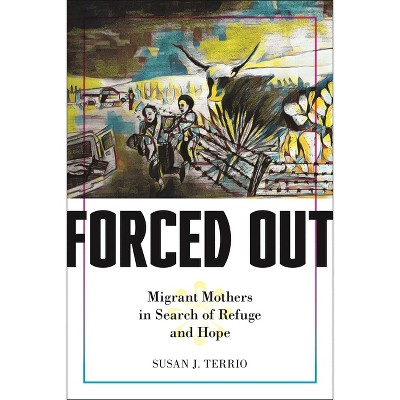Sponsored

There Was Nothing There - by Sara Martucci (Paperback)
$30.00
In Stock
Eligible for registries and wish lists
Sponsored
About this item
Highlights
- Explores the daily, lived effects of gentrification for neighborhood residents Williamsburg, Brooklyn, a prominent neighborhood in New York City, has undergone significant transformations through cycles of divestment and gentrification.
- About the Author: Sara Martucci is a Lecturer in the Department of Sociology at the John Jay College of Criminal Justice, City University of New York.
- 240 Pages
- Political Science, Public Policy
Description
About the Book
"There Was Nothing There: Williamsburg, The Gentrification of a Brooklyn Neighborhood explores the daily, lived-effects of gentrification for neighborhood residents- those who are newcomers and those who have remained as Williamsburg transformed around them"--Book Synopsis
Explores the daily, lived effects of gentrification for neighborhood residents
Williamsburg, Brooklyn, a prominent neighborhood in New York City, has undergone significant transformations through cycles of divestment and gentrification. In 2005, the city's decision to rezone the Williamsburg waterfront for high-rise housing led to a profound alteration of the physical, cultural, and social landscape. The result was the rapid influx of thousands of new residents, many of them wealthy, giving rise to luxury buildings, upscale dining, and high-end retail stores alongside new norms and expectations for the neighborhood. These new arrivals coexist with earlier gentrifiers as well as working-class Latinx and white ethnic populations, creating a complex and layered community. In There Was Nothing There, Sara Martucci draws on four decades of residents' memories and experiences, providing insights into the tensions, contradictions, and inequalities brought about by gentrification. Martucci focuses on the individual level, exploring how residents form connections to their neighborhoods and how these attachments shape their daily experiences of public spaces, local consumption, and evaluations of safety. As established residents, bohemians, and newcomers vie for ownership and belonging, their perceptions give rise to conflicting narratives that define the essence of the neighborhood. While the book's primary focus is Williamsburg, it serves as a cautionary tale about the broader impact of state-led gentrification, extending far beyond Brooklyn. The text underscores the potential consequences of such transformations for the future of cities, urging readers to consider the implications of cultural displacement, homogenization, and increased surveillance as gentrification permeates urban landscapes.Review Quotes
"[Martucci's] inclusion of current residents' voices and displaced and replaced businesses in illuminating cultural displacement and various types of neighborhood attachment is compelling ... The bibliography is thorough and the endnotes substantive. A strength of this study is the generalizability to other communities."-- "CHOICE"
"In a short time, Williamsburg went from being a neighborhood to avoid to a globally renowned brand for upscale bohemianism. It helped signal Brooklyn as a 'cool' place for investment. In this new lively new book, Martucci reminds us that even a hyper-gentrified neighborhood still has more social class and ethnoracial diversity than meets the eye. With the idea that groups experience the same spaces through their own distinct 'neighborhood attachment styles, ' she has given us a novel way of understanding how different people come to make sense of where they live. Most importantly, these styles shape social action and help explain everyday tensions that emerge from gentrification. Martucci's work will resonate with any reader who studies or lives in places undergoing massive change."-- "Richard Ocejo, author of Masters of Craft: Old Jobs in the New Urban Economy"
"Martucci carries the baton forward in her study of gentrifying Brooklyn. Her focus on 'attachment styles' captures the cross-cutting use values of residents in a rapidly changing neighborhood. There Was Nothing There shows how people can be in the same space, but not of the same place of mind."-- "Jason Patch, co-author of Gentrifier"
"Sara Martucci gives us a long view of gentrification in one North Brooklyn neighborhood where old timers, former bohemians, and condo owners offer competing narratives of community. While new construction and renovation clean up the area, police patrols and a swelling population of new, affluent, white residents create a feeling of safety that is no longer tied to ethnic groups and their turf. This is valuable testimony to the power of financial investment and aesthetic alteration to displace low-income residents and local shops, smoothing the jagged edges of uneven development."-- "Sharon Zukin, author of Naked City: The Death and Life of Authentic Urban Places"
About the Author
Sara Martucci is a Lecturer in the Department of Sociology at the John Jay College of Criminal Justice, City University of New York.Dimensions (Overall): 8.9 Inches (H) x 6.0 Inches (W) x .9 Inches (D)
Weight: .8 Pounds
Suggested Age: 22 Years and Up
Number of Pages: 240
Genre: Political Science
Sub-Genre: Public Policy
Publisher: New York University Press
Theme: City Planning & Urban Development
Format: Paperback
Author: Sara Martucci
Language: English
Street Date: May 21, 2024
TCIN: 89998433
UPC: 9781479815579
Item Number (DPCI): 247-38-9140
Origin: Made in the USA or Imported
If the item details aren’t accurate or complete, we want to know about it.
Shipping details
Estimated ship dimensions: 0.9 inches length x 6 inches width x 8.9 inches height
Estimated ship weight: 0.8 pounds
We regret that this item cannot be shipped to PO Boxes.
This item cannot be shipped to the following locations: American Samoa (see also separate entry under AS), Guam (see also separate entry under GU), Northern Mariana Islands, Puerto Rico (see also separate entry under PR), United States Minor Outlying Islands, Virgin Islands, U.S., APO/FPO
Return details
This item can be returned to any Target store or Target.com.
This item must be returned within 90 days of the date it was purchased in store, shipped, delivered by a Shipt shopper, or made ready for pickup.
See the return policy for complete information.











